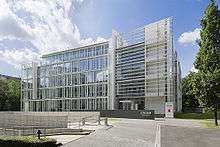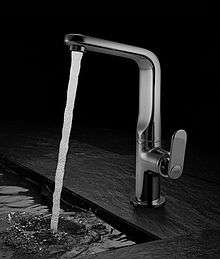Grohe
- For the Brazilian goalkeeper, see Marcelo Grohe
 | |
| Subsidiary of Lixil Group | |
| Industry | Sanitary Fittings |
| Founded | 1948 |
| Headquarters | Düsseldorf, Germany |
Area served | Worldwide |
Key people | Michael Rauterkus (CEO of Grohe AG) |
| Revenue | € 1.2 billion (2014) |
Number of employees | 6,000 (2015) |
| Website |
www |

GROHE is a sanitary fittings manufacturer with its registered office in Hemer and headquarters in Düsseldorf. Since 2014, Grohe has been a member of the Japanese Lixil Group. The company generated consolidated sales revenues of EUR 1.2 billion in 2014. Grohe currently employs about 6,000 people worldwide.
History
1911 until 1990: family-owned
The company started as a ferric hardware factory in 1911 under the name Berkenhoff & Paschedag, located in Hemer, Germany; it was taken over by Friedrich Grohe in 1936, who focused on sanitary faucets only. Before that, Friedrich used to work for his father's company Hansgrohe, founded in 1901. The first order from outside of Germany came in 1938. In 1948, the company was renamed to Friedrich Grohe Armaturenfabrik. In 1961, by which time the company had purchased a factory in Lahr/Schwarzwald, the company set up its first subsidiary abroad in France. A year later in 1962, Grohe acquired exclusive rights to produce the Moen Mixing Faucet, which mixes hot and cold water with a single lever.
In 1968, Friedrich Grohe sold a 51% stake , there were some additions to the Lahr production site and a new logistics dept was opened at Hemer-Edelburg.[1]
1990s and 2000s: involvement of investors

In 1991, the company bought two other producers of faucets: Herzberger Armaturen GmbH from the Brandenburg region and Armaturenfabrik H. D. Eichelberg & Co. GmbH at Iserlohn in Westphalia. Grohe was also restructured as a public limited company. By taking over the DAL group in 1994, the company acquired a production site in Porta Westfalica, Westphalia; at the same time, the company also acquired Tempress Ltd. of Mississauga in Ontario (Canada). At the Hemer site, new technology and factory control facilities were opened; in 1996 saw the company expand to Portugal and Thailand. A new design centre followed at the Hemer site in 1997.
In 1998, a group of investors working with BC Partners bought all available Grohe shares and delisted the company in the following year, making the Grohe Holding GmbH company, owned by BC partners, into the majority owner of Grohe AG in 1999. BC partners sold the company to a consortium of investors from the Texas Pacific Group and CSFB Private Equity (a subsidiary of the Swiss Credit Suisse banking group) five years later in 2004.
In 2005, Franz Müntefering, chairman of the then ruling German Social Democratic party (SPD), sparked a debate on capitalism by designating foreign private equity firms as "locusts".[2] He made TPG-owned Grohe his main example. The "locust" metaphor remained popular in German politics and media for years while the German government cited Grohe as an example for a successful turnaround only three years later.[3]
The company’s sales and profit figures had been stagnating for years, leading to a programme of savings as of 2005. Around 500 production jobs were cut at sites in Germany and the Herzberg factory was closed; the sites in Thailand and Portugal were expanded considerably. Through 2008, investments totalling 130 million euros were made in Germany in the area of production technology and logistics.
2010-present: recent history
GROHE was taken over by the LIXIL Group and the Development Bank of Japan in January 2014. .[4]

In 2012, Grohe AG’s revenues increased by 21 percent to 1,405 million euros; operating profits improved by 18 percent to reach 273 million euros, representing a return on revenue of 19.4 percent.[5] Grohe is currently Europe’s biggest manufacturer of sanitary fittings and has eight percent of the worldwide market.[6] The German market makes up roughly 15 percent of overall sales. Currently, Grohe AG is owned almost 100% by Grohe Holding GmbH (there are still some minority shareholders from the period in which Grohe AG was listed on the stock market). Grohe Holding GmbH is owned by investors.
June 2010 saw a ruling against the European sanitary fittings industry by the European Commission. The Commission found that European manufacturers had operated a cartel between 1992 and 2002 and imposed a collective fine of 622 million euros. Grohe’s share of the fine amounted to 54.8 million euros.[7] The current Grohe board of directors, which took up business after the period under investigation, introduced awareness programmes about competition law and operates a zero-tolerance policy towards price-fixing.[8]
In early 2011, Grohe acquired a majority stake in the leading Chinese sanitary fittings producer Joyou, making a successful public takeover bid. The aim of this takeover is above all to strengthen Grohe’s sales infrastructure on the fast-growing Asian market.[9] Grohe currently holds a 72 percent stake in Joyou.[5]
In May 2013, David Haines, chairman of Grohe, confirmed that, although the company is examining all options for ending investor involvement, no concrete plans had yet been made. Capital market experts estimate that Grohe would currently be valued at up to four billion euros if it were to return to the stock market.[10]
In September 2013, it was announced that Grohe had received the largest ever investment from a Japanese company in the country. The firm is now almost entirely owned by the Japanese building materials company Lixil and Development Bank of Japan, after a €3 billion deal for 87.5 percent of the firm.[11]
Grohe in the U.S.
In 1975, Grohe opened a small office just outside Chicago and its representative, Urell, Inc. in Massachusetts, began supplying European-style kitchen and bathroom fixtures to American tradesman and retailers. The new venture was incorporated a year later as Grohe America, Inc. and moved into a small warehouse-office complex. In order to keep pace with its rapid growth, the company regularly upsized its premises: a section of a larger warehouse facility in 1978; a whole warehouse in Wood Dale in 1986, finally settling into today’s custom-built 90,000 square foot facility in Bloomingdale, Illinois, in 1993.[1]
Sales figures doubled year after year as Grohe introduced a series of products such as the Ladylux of 1983 – the first pull-out spray kitchen faucet, including detachable hand-spray* and snap-on accessories* (also the first hand-spray with a filter for drinking water*), on the US market – or the Europlus of 1989, another pull-out spray faucet. In the early 1990s, Grohe introduced a new designer finish "white" which increased sales dramatically for the next 7 years. Introduction of clear powder-coating in the 1980s resulted in the advent of polished brass and other finishes with superior adhesion, solving a major problem in the industry. In the late 1990s, Grohe replaced the powder-coated first generation of these products with stainless steel versions.
1979 saw the launch of the Grohmix thermostat line, able to regulate water temperature to within one degree Fahrenheit of accuracy. As of 1980, Grohe also implemented water-temperature regulation technology in its successful range of custom showers which is still a strong seller in the marketplace due to its unique design.
These shower systems saw Grohe America take the step of advertising directly to consumers. For commercial customers, Grohe introduced a new product line in 1989, following it up with a showroom marketing program for wholesalers. In 1996, Grohe America launched its first television advertisement campaign and started offering a limited lifetime warranty as of 1997. By the mid-1990s, Grohe America was selling fixtures with a value of $38 million annually, with a market share of 1.7 percent.
Grohe opened a 15,000 square-feet showroom for professional partners and visitors on Fifth Avenue, New York in September 2011.[12] In February 2012, Grohe announced its US headquarters will move from Bloomingdale, Illinois to New York City.[13]
References
- 1 2 http://www.fundinguniverse.com/company-histories/Friedrich-Grohe-AG-amp;-Co-KG-Company-History.html
- ↑ http://www.dw.de/dw/article/0,,1589069,00.html
- ↑ http://www.ft.com/intl/cms/s/0/7d885ddc-331c-11dd-8a25-0000779fd2ac.html
- ↑ http://www.grohe.com/30212/about-company/the-grohe-group/
- 1 2 http://www.grohe-group.com/en/press/press-releases/p/25_8630.html?item=1155&id_cat=77
- ↑ http://www.grohe.com/en/about-grohe/facts-figures/p/25_8628.html
- ↑ http://europa.eu/rapid/pressReleasesAction.do?reference=IP/10/790&type=HTML
- ↑ http://www.grohe.com/htlib/3/PDF/GROHE_CoB.pdf
- ↑ http://www.reuters.com/finance/stocks/JY8G.DE/key-developments/article/2344643
- ↑ http://uk.reuters.com/article/2013/05/13/uk-grohe-ipo-idUKBRE94C0Q420130513
- ↑ http://www.thelocal.de/money/20130926-52109.html
- ↑ http://www.grohe.com/en/press/press-releases/p/25_8630.html?item=788&id_cat=77
- ↑ http://www.supplyht.com/Articles/Bath_and_Kitchen_News/BNP_GUID_9-5-2006_A_10000000000001158566
15. * Brian Stearns - Engineer/Designer 1979-1990